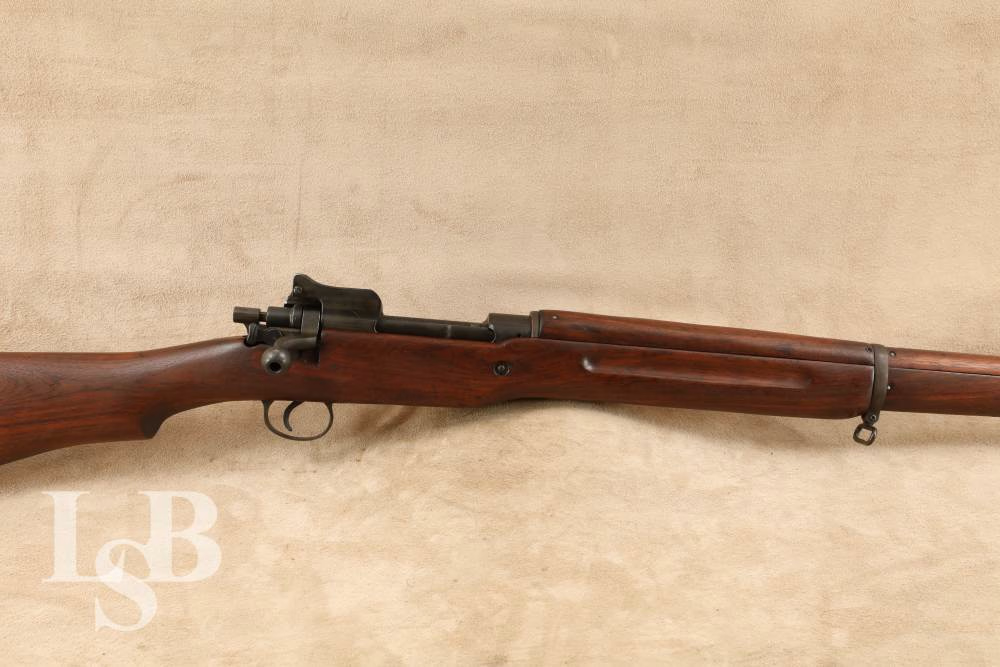
U.S. Remington Eddystone M1917 Enfield Bolt Action Rifle .30-06, 1918 C&R
SOLD FOR: $1,230.00
LSB#: LSB250608WJ025
Make: Remington Eddystone Arms
Model: M1917
Serial Number: 946319
Year of Manufacture: September 1918
Caliber: .30-06 Springfield
Action Type: Bolt action, 5 round internal magazine
Markings: The top of the receiver is marked, “U.S. / MODEL OF 1917 / EDDYSTONE / 946319” The bolt handle is marked with an Ordnance Corps “Flaming Bomb”. The stock is marked, “3GM-K” The top of the barrel is marked, “E 8 18” and with an Ordnance Corps “Flaming Bomb”.
Barrel Length: 26”
Sights / Optics: The front sight is a bladed post set between two protective wings. The rear sight is set between two large protective wings. When flipped up it becomes a sight ladder that uses a sliding aperture.
Stock Configuration & Condition: The wood stock has a semi-pistol grip, finger grooves, nose cap with bayonet lug & stacking loop, barrel band with sling loop, through bolt, sling loop, and a metal buttplate with a hinged door for storage. The buttplate is pitted with light wear at the edges. There are small compression marks, scuffs, and scratches throughout the wood. There are a few gouges, none more than 1/8” deep, that did not sand out at refinish. There are no cracks or chips. The LOP measures 13.5” from the front of the trigger to the back of the buttplate. The stock rates a Fine overall condition as arsenal refurbished.
Type of Finish: Parkerized
Finish Originality: Original
Bore Condition: The bore is semi-bright and the rifling is worn. There is faint erosion in the bore. In this writer’s opinion, this bore rates 8/10.
Many military and C&R eligible weapons have bores that will show erosion. This is not only due to age but to the fact that corrosive primers were commonly used in ammunition worldwide. For example, the U.S. used corrosive ammunition throughout WWII. The U.S. military did not begin to phase out corrosive-primed ammunition until the 1950s.
Overall Condition: This rifle retains about 90% of its metal refinish. There is moderate operational wear on both right receiver rails and on the claw extractor. There are tiny scratches, and spots of patina throughout. There is blueing loss at the edges of the muzzle and upper band. There is moderate corrosion pitting on the upper band. The screw heads show moderate tooling but are still quite serviceable. The markings are mostly clear, though some of the smaller proof and acceptance marks are worn around their edges. Overall, this rifle rates a Fine condition.
Mechanics: The action functions correctly. We did not fire this rifle. As with all used firearms, a thorough cleaning may be necessary to meet your maintenance requirements.
Box, Paperwork & Accessories: None.
Our Assessment: In 1910, the British were developing a new rifle as a replacement for the Short Magazine Lee-Enfield, which had entered service in 1895. They were impressed with many of the characteristics of the Mausers of the day , to include a one-piece stock and a receiver-mounted aperture rear sight. Their efforts produced the Pattern 13 Enfield, chambered in .276, a little too slowly. World War One started the next year and they attempted to revert to .303 British chambering with the new rifle (called the Pattern 14) but Vickers, their lead manufacturer, ran into problems.
The outbreak of the Great War was a terrible time to have “problems” in one’s small arms manufacturing. The British acted decisively. Their twofold solution was to continue to produce the SMLE at the arsenals that were already making it, and to let a licensed production contract to US manufacturers Winchester and Remington. A third arsenal was stood up in the Baldwin Locomotive Works in Eddystone, Pennsylvania.
When the US entered the war in 1917, it too had a sudden need to produce a lot of rifles. Though the Model 1903 was in production, US thinking was that it would be much quicker for the three companies to continue to produce rifles in the Enfield design — albeit chambered in .30-06 (the US military standard). Thus was born the M1917 (or P-17, in British parlance) – the American Enfield.
Though considered a secondary rifle by both nations, the P-14 and P-17 were produced in great quantities. During World War I, more M1917s were produced than the more familiar M1903. Eddystone produced more of the rifles than Remington and Winchester combined. It has been estimated that about 75% of the American Expeditionary Force carried the M1917. Sgt Alvin York won his Medal of Honor with a M1917 rifle (and a 1911).
After the War, most M1917s were placed in storage, while some were sold as surplus. After Pearl Harbor, the US entered WW2 short of rifles again, and the M1917 came out of storage and was issued to artillery and rear-echelon troops. It armed allied Filipinos and Nationalist Chinese forces.
Here is a chance to own an “American Enfield” (officially U.S. Rifle, caliber .30, Model of 1917). It is a significant piece of 20th Century history and is in really good shape. Please see our photos. -C.B.

